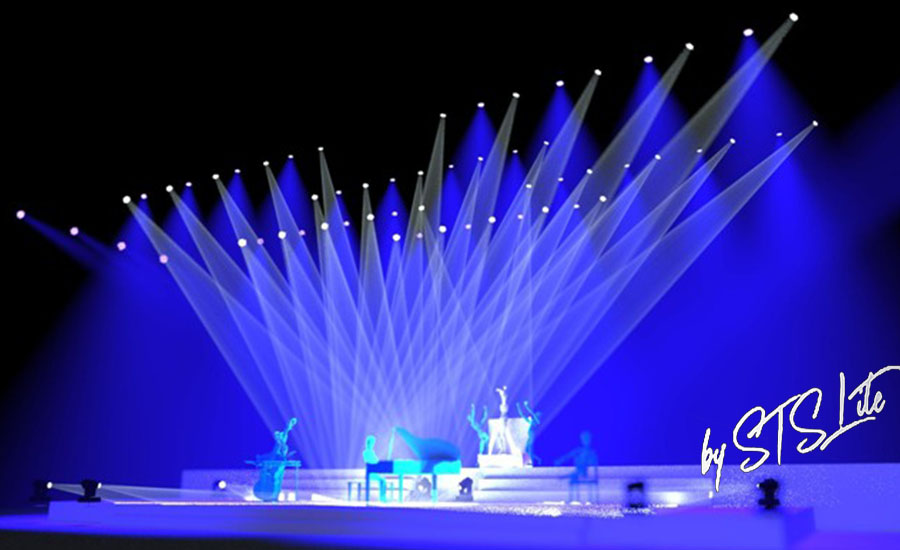The new campus inspirational drama "holding up tomorrow's sun" (hereinafter referred to as "Tuo" Drama) was first put on the stage in the 1990s and has toured more than 3700 times across the country. In 2009, the play was adapted by the drama troupe of Jiamusi Art Theatre and other units and presented on the stage again. The adapted "Tuo" shows many characteristics of modern stage art, especially in lighting design. Due to the great progress of lighting technology and artistic concept in this decade, the lighting design of Tuo plays a richer emotional interpretation and plays an important role in the dramatic structure and stage space-time transformation.

The story of Tuo drama is about the rehearsal process of a drama, so it naturally presents two drama time and space on the stage, forming a dramatic structure of "play in play". Among them, segment a is the time and space for the live rehearsal of the play. Because this space-time adds the interaction between the "director", "actor" and other staff and the on-site audience, the audience has the current "real space-time" positioning of this space-time. The play being rehearsed in the play has become section B of Tuo and the "virtual time and space" of the audience.
In order to adapt to this special dramatic structure, the choreographer built a cutting platform with an elevation of 10 degrees on the stage to form the stage in the stage. Spatially, the two time and space are distinguished and separated. Although the distance between the two stages is often broken by the activities of the characters, under the specified scenes, This kind of break can be accepted and understood by the audience. And this understanding has been an important help for the lighting effect in the space-time switching link and the separation effect between virtual and reality.

For example, in stage B, Xiao Hong expresses her worry that she can't do things according to her wishes in the classroom alone, sings the song "I'm a little bird", and the whole audience is full of red lights. At the same time, this juvenile's worry is accompanied by more and more strong hope, which infects every audience with the full red, so that the drama and the audience reach a high emotional resonance. At the end of the song, the red light disappeared, and a beam of white chasing light on the left front desk of the stage brought up Xiaohong's mother and Xiaohong's teacher. The bright black-and-white lights quickly put the audience into rational thinking from the torrent of emotional catharsis. Xiaohong's mother analyzes the relationship between parents and children from the opposite position of Xiaohong, and the teacher analyzes Xiaohong's mother's position. In this way, one positive and one negative, one emotion and one reason, as well as the black-and-white lighting atmosphere of the whole audience, every audience present can no longer escape the resonance field brought to them by stage B. Just then, drama B was suddenly interrupted by the white light (theater work light) effect of the whole audience“ The director "came on stage to guide the rehearsal of the play. The audience instantly returned to the real time and space and suddenly understood: "Oh, they are rehearsing." The traditional drama structure is interrupted, and the development process of drama performance, narration and emotion presents a kind of "strangeness", which is called "alienation" by Bertolt Brecht. This separation effect can easily lead to the audience's incomprehension of the traditional drama and the blurring of the boundary of the transformation of double time and space. If we only create this separation effect through lines and dance scenery, it is often laborious and ineffective. However, if the light is used to make large contrast changes in color, tone and light and shade to create this separation effect, it will have twice the effect with half the effort. Just as the conversion between these two scenes in Todd is realized through the great contrast change of light tone and brightness.

In Tuo, the dramatic structure of "play in play" makes the two time and space of stage a and stage B intertwined. They are frequently exchanged without changing scenes, and do not close or even have a black scene. In order to more clearly indicate the time and space of the current stage, the lighting designer simply positioned the time and space of stage a in the stage working light, that is, the lighting effect based on the tone of high brightness white light, and explained and rendered the time and space in stage B with rich and full color lighting effects. This arrangement is not arbitrary, but carefully designed by lighting designers. The former is to express the realistic style of objective narration in stage a, while the latter is to meet the romantic needs of venting the role's profound and changeable emotional world.
The two lighting effects with different styles have been perfectly integrated on the stage of the drama holding up tomorrow's sun, and skillfully completed the manufacture of drama separation effect. It is a successful case worthy of our drama workers to learn.
Copyright © 2021 GuangZhou STS Lighting Equipment Co.,Ltd. | All Rights Reserved